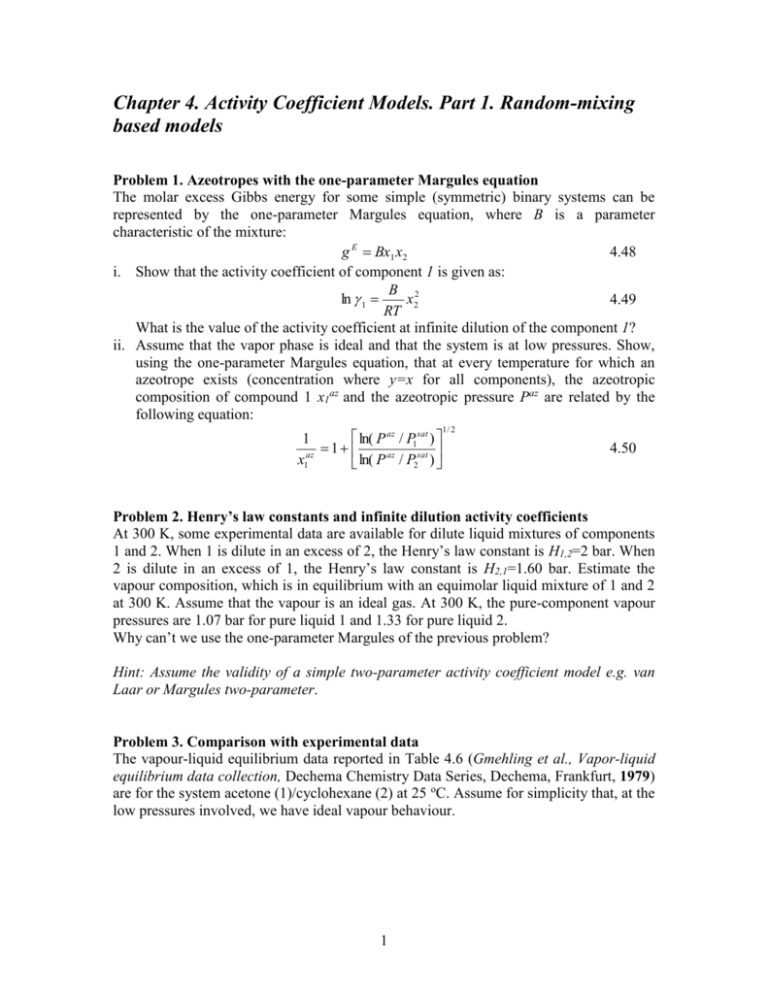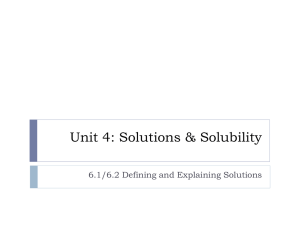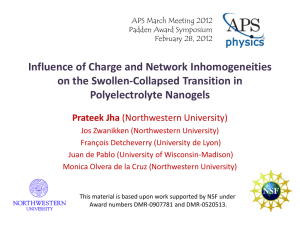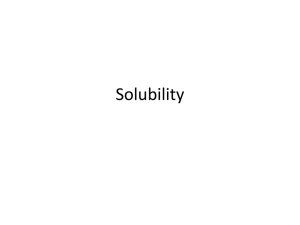Chapter 4
advertisement

Chapter 4. Activity Coefficient Models. Part 1. Random-mixing based models Problem 1. Azeotropes with the one-parameter Margules equation The molar excess Gibbs energy for some simple (symmetric) binary systems can be represented by the one-parameter Margules equation, where B is a parameter characteristic of the mixture: 4.48 g E Bx1 x2 i. Show that the activity coefficient of component 1 is given as: B 2 ln 1 x2 4.49 RT What is the value of the activity coefficient at infinite dilution of the component 1? ii. Assume that the vapor phase is ideal and that the system is at low pressures. Show, using the one-parameter Margules equation, that at every temperature for which an azeotrope exists (concentration where y=x for all components), the azeotropic composition of compound 1 x1az and the azeotropic pressure Paz are related by the following equation: ln( P az / P1sat ) 1 1 az sat x1az ln( P / P2 ) 1/ 2 4.50 Problem 2. Henry’s law constants and infinite dilution activity coefficients At 300 K, some experimental data are available for dilute liquid mixtures of components 1 and 2. When 1 is dilute in an excess of 2, the Henry’s law constant is H1,2=2 bar. When 2 is dilute in an excess of 1, the Henry’s law constant is H2,1=1.60 bar. Estimate the vapour composition, which is in equilibrium with an equimolar liquid mixture of 1 and 2 at 300 K. Assume that the vapour is an ideal gas. At 300 K, the pure-component vapour pressures are 1.07 bar for pure liquid 1 and 1.33 for pure liquid 2. Why can’t we use the one-parameter Margules of the previous problem? Hint: Assume the validity of a simple two-parameter activity coefficient model e.g. van Laar or Margules two-parameter. Problem 3. Comparison with experimental data The vapour-liquid equilibrium data reported in Table 4.6 (Gmehling et al., Vapor-liquid equilibrium data collection, Dechema Chemistry Data Series, Dechema, Frankfurt, 1979) are for the system acetone (1)/cyclohexane (2) at 25 oC. Assume for simplicity that, at the low pressures involved, we have ideal vapour behaviour. 1 Table 4.6. VLE of acetone (1)/cyclohexane (2) at 25 oC. Pressure x1 y1 Activity Activity (mmHg) Coefficient of Coefficient of compound (1) compound (2) 97.45 0.0 0.0 118.05 0.0115 0.1810 172.90 0.0575 0.4580 253.90 0.4235 0.6800 259.40 0.5760 0.7050 252.00 0.9250 0.8580 243.80 0.9625 0.9160 230.40 1.0000 1.0000 i. Calculate the experimental activity coefficients of the two compounds and complete the table above. Do we have positive or negative deviations from Raoult’s law? ii. Use a single experimental data point (at P=253.9 mm Hg) to estimate the parameters of an activity coefficient model and then calculate the equilibrium pressure and vapour compositions at liquid acetone concentrations: 0.0115, 0.5760 and 0.9625. Prepare a table showing for these three compositions the percentage deviations between calculated and experimental activity coefficients (for both components), equilibrium pressures and vapour phase mole fractions. Compare the results to the experimental data and comment on the results. Hint. For the van Laar equation, show that the parameters A and B for a binary system can be obtained using the activity coefficient values for the two compounds using the equations: ln 1 x1 B ln 2 1 ln 2 x 2 AB ln 1 ln 2 x2 x1 2 4.51 2 Problem 4. The van Laar equation i. Show that the two forms of the van Laar equation [equations 4.9 and 4.10] are equivalent. What is the value of ln 1 using the two forms of the van Laar equation ? ii. Show that when the van der Waals parameters are obtained from the critical point, then Pc (where is defined as in equation 4.9). iii. Chlorine ( Pc 7.71 MPa) and carbon tetrachloride ( Pc 4.56 MPa) form an ideal solution. On the other hand, carbon disulfide ( Pc 7.9 MPa) and 2 iv. methanol ( Pc 8.10 MPa) split into two liquid phases. Can the van Laar equation explain these observations ? 2 Starting from g E b 1 2 1 2 derive the expression for the activity coefficient (eq. 4.9) for a binary mixture (b is the mixture co-volume parameter and is defined as in equation 4.9). The “segment” fractions are defined in equation 4.9 and Table 4.4. Hint: Show first that the excess Gibbs energy for the van Laar equation can be written as: x x bb 2 4.52 g E 1 2 1 2 1 2 b Problem 5. K-factors for distillations using the Regular Solution Theory (Modified from Prausnitz et al.6) For distillation-column design, we need K factors (Ki=yi/xi). A liquid mixture at 50 oC contains 30 mol% n-hexane and 70 mol% benzene. At 50 oC, the pure component vapour pressure of n-hexane is 0.533 bar and of benzene is equal to 0.380 bar. 1. Calculate the K factors of n-hexane and benzene in this mixture. Assume that the pressure is sufficiently low to neglect gas-phase corrections and Poynting factors. Then calculate the relative volatility of hexane/benzene. 2. What would be the relative volatility assuming an ideal liquid solution? The molar volumes and solubility parameters are presented in Table 4.7. Table 4.7. Molar volumes and solubility parameters for n-hexane and benzene (all values at 25 oC). Compound Volume (cm3/mol) n-hexane Benzene 132 89 Solubility parameter (J cm-3)1/2 14.9 18.8 Problem 6. Azeotropes with the Regular Solution Theory (Modified from Prausnitz et al.6) A binary liquid mixture contains the non-polar components 1 and 2. The mixture is to be separated by ordinary distillation. To determine if this is feasible, it is necessary to know whether or not the mixture has an azeotrope. The pure component vapour pressures at 300 K and the solubility parameters are given for the two compounds in Table 4.8. The pure-component molar volumes are for both compounds equal to 160 cm3/mol. At 300 K, does this mixture have an azeotrope? If so, what is its composition? Assume that the vapour phase is ideal. What would the result be if both liquid and vapor phases are considered ideal ? 3 Table 4.8. Pure component vapour pressures and solubility parameters at 300 K for the two components. Compound Vapor Pressure (kPa) (1) (2) 53.3 80 Solubility parameter (J cm-3)1/2 14.3 17.4 Problem 7. Using azeotropic data to predict VLE for a binary mixture (From Sandler, S.I., Chemical and Engineering Thermodynamics (3rd edition). John Wiley & Sons, 1999) Benzene and cyclohexane form an azeotrope at 0.525 mole fraction benzene, temperature of 77.6 oC and a total pressure of 1.013 bar. At this temperature the vapour pressure of pure benzene is 0.993 bar and that or pure cyclohexane is 0.980 bar. i. Using the van Laar model, estimate the activity coefficients of benzene and cyclohexane at liquid mole fractions (benzene) 0.0, 0.2, 0.5, 0.8 and 1.0. Using this activity coefficient information, compute the equilibrium pressure versus liquid and vapour composition at the same temperature. ii. Make predictions for the activity coefficients of benzene and cyclohexane using the regular solution theory and compare these with the results obtained in question (i). Volume and solubility parameters of benzene are given in problem 5, while for cyclohexane they are 109 cm3/mol and 16.8 (J/cm3)1/2. Problem 8. Interrelations between models – Derivations 1. Starting from the expression of the regular solution theory for multicomponent systems using lij=0, derive the expression for binary systems (equation 4.11). 2. The excess Gibbs free energy equation of the van Laar equation is prior to the assumption of any mixing rules given as: g E xi i i 4.53 a b Consider a binary mixture. Derive the expression for the activity coefficient of compound (1) in the following cases (types of mixing rules): i. xi i 4.54 i ii. xi x j ij i ij i j 4.55 j iii. the classical van der Waals one fluid mixing rules for the energy and co-volume parameters (a,b) using also the well-known geometric mean combining rule for the cross energy parameter and the arithmetic mean rule for the cross co-volume parameter (equations 3.2 and 3.3 in Chapter 3). Assume that all interaction parameters (kij and lij) are equal to zero. 4 Comment on the results and mention examples of mixtures your three models can potentially be applied to. Problem 9. Permeability of pharmaceuticals through polymers using the Regular Solution Theory dC Starting from Fick’s law: J D 4.56 dx Derive the equation for the permeability of pharmaceuticals through polymers using the Flory-Huggins/Regular solution theory, according to Michaels et al.25 (equation 4.25): S f Tm 4.57 ln J max l exp(1 ) 1 ln ( D) R T where the maximum attainable flux of a pharmaceutical through the polymer is given by: D.C * J max 4.58 l D is the diffusion coefficient, l is the thickness of the film and C* is the concentration of the pharmaceutical in the polymer at equilibrium with crystalline solid steroid. Hint: Show first that the FH equation for the activity of the pharmaceutical at very low solubilities can be given by the equation: ln a1 ln 1 (1 12 ) . Problem 10. Screening of solvents for pharmaceuticals using the regular solution theory (RST) i. Starting from the expression for the activity coefficient of RST (lij=0) for multicomponent systems: 2 V ln i i i av RT m av i i 4.11 i 1 derive the expression for a binary mixture (components 1 and 2) ii. What are the expressions for the infinite dilution activity coefficients of compounds 1 and 2 ? iii. Show that in the case of solid-liquid equilibria, the (real) solubility of a solid (2) in a liquid (1) is given by the equation: x 2real x 2ideal 4.4 2 5 iv. Kolar et al., (Fluid Phase Equilibria, 2002, 194-197, 771-782) and Abildskov and O’Connell (Ind. Eng. Chem. Res., 2003, 42, 5622-5634) have illustrated how the RST can be used for screening solvents for pharmaceuticals. The key concept derived from RST is that (at low solute concentrations) the solubility x2 is a parabola with respect to the solubility parameter of the solvent 1 with a maximum located at: 1 2 [ 2 is the solubility parameter of the pharmaceutical]. Illustrate this by showing that for the RST and for low solute (2) concentrations, the following equation is derived: VL VL VL 4.59 ln x2 2 12 2 2 2 1 ln x2id 2 22 RT RT RT Figure 4.10 shows the lnx2 - 1 plot of hydrocortisone at 298.15 K. The enthalpy of fusion, liquid volume and melting point of this solid are 34.87 kJ/mol, 0.293 m3/kmol and 485.5 K, respectively. Figure 4.10. Plot of lnx2 - 1 of hydrocortisone at 298.15 K. From Abildskov and O’Connell (Ind. Eng. Chem. Res., 2003, 42, 5622-5634). Reprinted with permission from American Chemical Society (2003). i. ii. iii. calculate the ideal solubility at 298.15 K and provide, based on the plot, an estimate of the solubility parameter of the solid. what is the solubility of hydrocortisone in carbon tetrachloride, based on the plot and on the equation shown in this problem? Explain, with reference to figure 4.4, why RST performs well for morphine but not for the other pharmaceutical. 6 Problem 11. LLE with the regular solution theory Show for the RST that a mixture of two components (1and 2) will give two liquid phases if ( Tc = critical solution temperature): RTc x1 2 x1 x 2V12V22 x1V1 x2V2 3 1 2 2 4.60 V12 V22 V1V2 V1 V2 V1 What are the LLE conditions if the two components have equal liquid volumes? 4.61 Problem 12. Infinite dilution conditions i. For polymers, weight fraction activity coefficients are often used: 1 1 4.62 w1 Show that, for a binary solvent(1)/polymer(2) solution, the infinite dilution activity coefficients of the solvent based on molar and weight fractions are related via the equation: M 4.63 1 1 2 M1 where M1 is the molecular weight of the solvent and M2 is the molecular weight of the polymer. ii. For the benzene/PIB(50000 g/mole) solution with solvent's weight fraction equal to 0.0564 and molar activity coefficient 1 =0.3396, show that: - the mole fraction of the solvent is equal to 0.9745. - the activity of the solvent is equal to 0.331. - the weight fraction activity coefficient of the solvent is equal to 5.868. Problem 13. Solubility Parameters i. Mixed Solvents Cellulose nitrate (10.27 H) is insoluble in both ethyl ether (7.4 H) and ethanol (12.7 H). Can this polymer be soluble in a mixture of the two ? Why/Why not ? At which composition? (the values in parentheses are the solubility parameters in Hildebrand units, i.e. cal1/2/cm3/2). ii. Hansen solubility parameters A polymer has a solubility parameter equal to 9.95 (with dispersion, polar and hydrogen bonding parts equal to 7.0, 5.0 and 5.0) and a solubility Radius equal to 3.0. Is it certain that a solvent with a solubility parameter equal to 10 (8.0, 6.0, 0.0 are the dispersion, polar and hydrogen bonding parts, respectively) will dissolve it? Why/Why not? The solubility parameter and radius values are in Hildebrand units, i.e. cal1/2/cm3/2. 7 Problem 14. Solubility of mixed solvents in commercial paint resins - An industrial case Mixed solvents are often used in the paints and coatings industry. The choice of suitable solvents is often based on the three-dimensional Hansen theory. For a mixed solvent, the solubility parameter is given by the equation: 4.64 i i i where i is the volume fraction of the solvent i and i are its solubility parameters (either total solubility parameter or the Hansen solubility parameters: d , p , h ). For two resins, a polyester resin known as Desmophen (product of Bayer) and an epoxy resin known as Epikote 1001 (product of Shell) and for two possible solvents, n-butanol and xylene, the Hansen solubility parameters are given in Table 4.9. The solubility radius is for the polyester resin equal to R=8.2 and for the epoxy resin is R=6.20. i. Are the two resins soluble in xylene? ii. Is the polyester resin soluble in a mixed solvent composed of n-butanol/xylene with 80% volume fraction of xylene? iii. Is the epoxy resin soluble in a mixed solvent composed of n-butanol/xylene with 55% volume fraction of xylene? iv. Explain briefly the results. The solubility parameter and radii values are in Hildebrand units, i.e. cal1/2/cm3/2. Hint: The basic equation which determines the solubility range according to Hansen’s method is: 4 d 1 d 2 p1 p 2 h1 h 2 R 2 2 2 4.65 Table 4.9. Hansen solubility parameters for Desmophen and Epikote 1001 for two possible solvents, n-butanol and xylene. Compound d p n-butanol Xylene Epikote 1001 Desmophen 7.8 8.7 9.95 10.53 2.8 0.5 5.88 7.30 h 7.7 1.5 5.61 6.0 Problem 15. Evaporation of isopropanol from a PVAC film (Modified from Prausnitz et al.6) A film of poly(vinyl acetate), PVAC, contains traces of isopropanol. For health reasons, the alcohol content of the film must be reduced to a very low value: government regulations require that that the volume fraction of isopropanol should obey the relationship: 1 104 . To remove the alcohol, it is proposed to evaporate it at 125 oC. At this temperature, chromatographic experiments, which are carried at infinite dilution of 8 alcohol, give a value of the Flory-Huggins parameter equal to 0.44. The vapor pressure of alcohol is 4.49 bar. Assuming that the PVAC is of very high molecular weight, calculate the low pressure, which must be maintained in the evaporator to achieve the required purity of the film. What would the value of pressure be if i) the Flory-Huggins parameter is assumed equal to zero (near-athermal solution), ii) if the solution is assumed ideal. Comment on the results. Hint: Under the conditions prevailed here, the activity of the solvent is simply given as the ratio of the partial pressure to the solvent vapor pressure and the polymer is assumed to be completely non-volatile. Problem 16. The Flory-Huggins model i. Show that, for the Flory-Huggins model, one of the most widely-used models for polymers, the molar-based activity coefficient at infinite dilution is, for a binary solution, given by the equation: V1 V 4.66 1 1 12 V2 V2 Derive also the infinite dilution activity coefficient expression for compound (1) in a binary solution for the Entropic-FV combinatorial-Free Volume term (equation 4.19). ii. At the critical solution temperature, the following conditions apply: ln 1 4.67a 0 2 ln 1 ln 2 ln 1 0 4.67b 22 Derive the following equations for the critical Flory-Huggins interaction parameter and the critical volume fraction: 1 4.68a crit 2 1 r 2 1 1 4.68b 1 2 r What are the values of the critical volume fraction and FH parameters for “high” polymers (i.e. polymers of high molecular weight)? crit 1 Hint: Use the FH model written for the solvent activity as: 1 ln 1 ln 1 1 2 12 22 r 4.69 Problem 17. Are phthalates completely miscible in PVC? There are, especially in the recent years, many debates regarding the use of phthalates like DOP (dioctyl phthalate) as plasticizers in several polymers and especially PVC 9 (polyvinyl chloride). Plasticizers are added in PVC because they can lower the glass transition temperature of the polymer, but it has now been established that DOP and other plasticizers sometimes migrate to the surface. This phenomenon results to the destruction of the plastic material and may cause health problems as well, since certain phthalates are considered to be dangerous chemicals (carcinogenic). Tables 4.10 and 4.11 present values of the Hildebrand and Hansen solubility parameters, the Hansen solubility radius as well as the Flory-Huggins parameters for PVC and DOP. Figure 4.11 shows how the FloryHuggins parameter for PVC/DOP depends on concentration, according to Su et al., (J. Appl. Polymer Sci., 1976, 20, 1025-1034). On basis of this information, can we conclude that DOP is completely soluble (miscible) in PVC? (If yes, this would imply that the cause of DOP migration cannot be fully explained by thermodynamics). Justify your answer. Table 4.10. Solubility parameters of PVC and DOP (all values are given in Hildebrand units = (cal/cm3)1/2) from various sources: A.F.M. Barton. CRC Handbook of polymerliquid interaction parameters and solubility parameters. CRC Press, 1990; C.M. Hansen. Hansen Solubility Parameters. A User’s Handbook. CRC Press, 2000. Compound total value DOP-1 7.94 DOP-2 8.92 PVC-1 9.314 PVC-2 11.03 PVC-3 10.49 dispersion polar hydrogen bonding 8.14 3.2 1.52 9.4 8.91 4.5 3.68 3.5 4.08 R-Hansen 3.2 1.7 Table 4.11. Flory-Huggins (FH) parameters for the PVC/DOP system obtained from various measurements. Anagnostopoulos et al. T (oC) 53 76 116-118 Bigg Patel and Gilbert 113-114 Reference Doty and Zable FH parameter 0.01 0.03 -0.03 0.06 - extrapolated from swelling data 0.05 -0.13 P.M. Doty, H.S. Zable, J. Polym. Sci., 1946, 1, 90; C.E. Anaglostopoulos, A.Y. Coran, H.R. Gamrath, J. Appl. Polym. Sci., 1960, 4, 181; D.C.H. Bigg, J. Appl. Polym. Sci., 1975, 19, 3119; S.V. Patel, M. Gilbert, Plast. Rubber Process Appl., 1986, 6, 321. 10 Problem 18. The Flory-Huggins model For the polymer solution cyclohexane (1) / polystyrene (2) [PS] the FH parameter is available at solvent volume fraction 1 =0.60 and it is 12 =0.72. The density of cyclohexane is 0.7575x103 kg/m3 and the density of the polymer is 0.10482x104 kg/m3. The average molecular weight of PS is 25900 g/mol. All data are reported at the same temperature (=373.15 K). i. Estimate the activity of the solvent as well as the activity coefficient of the solvent (based on weight fractions) at solvent weight fraction w1=0.55. What is the percentage deviation as compared to the experimental value 1 =1.802 reported by Krigbaum and Geymer, J. Amer. Chem. Society, 1959, 81(8), 1859-1959? ii. Estimate the FH-parameter value so that the experimental activity coefficient value (at w1=0.55) is reproduced. Figure 4.11. The Flory-Huggins interaction parameter for the PVC/DOP system ( 23 ) as a function of concentration (volume fraction of PVC). From Su, Patterson and Schreiber J. Appl. Polymer Sci., 1976, 20, 1025-1034. Reprinted with permission from Wiley (1976). Problem 19. Pressure of a polymer solution using Flory-Huggins (From Prausnitz et al.6). Estimate using the Flory-Huggins model, the total pressure of a liquid solution containing 50% (weight-based) polyvinyl acetate (with molecular weight equal to 83400 g/mol) and 50% vinyl acetate (molecular weight = 84.1 g/mol) at 125 oC. At this temperature, the density of the polymer is 1.11 g/cm3 and that of the solvent is 0.783 g/cm3. The vapor 11 pressure of the solvent is 3340 Torr (mmHg). From experiments, we know that the ratio of the pressure to the solvent weight fraction at infinite dilution, i.e. the so-called Henry’s P law constant is 18.3 bar: lim( w1 0) 18.3bar w1 What is the most important assumption involved in the calculations? Problem 20. Infinite dilution activity coefficients via Flory-Huggins Ashworth and Price, (Macromolecules, 1986, 19(2), 358-263) published the FloryHuggins interaction parameter values for the system benzene (1) / polydimethylsiloxane (2) at various concentrations and at temperature T = 30 oC. i. Estimate the activity and the weight-fraction activity coefficient of the solvent at volume fraction 1 =0.0165. At this concentration the value of the FH parameter is 0.7317. ii. Prove that, for the Flory-Huggins model, the molar-based and weight-based activity coefficients at infinite dilution are given by the equations: V V 4.70 ln 1 ln 1 1 1 12 V2 V2 and 1 M2 1 4.71 1 exp 12 1 r M1 r iii. Estimate the values of the above two activity coefficients at infinite dilution of the solvent (at molar basis and weight-fraction basis) Data: solvent: density = 11.11 g/cm3, molecular weight=78.11 g/mol. polymer: density=0.9523 g/cm3, average molecular weight=3350 g/mol. Problem 21. Selective dissolution Selective dissolution is a separation process which has been proposed for recycling of polymers. The separation is possible because the individual polymers in a mixture of different polymers are dissolved in different solvents. A typical mixture of polymers is composed of polyethylene (PE), polystyrene (PS) and polyvinylchloride (PVC). Choose based on the data available in tables 4.12 and 4.13 three suitable solvents for each polymer and fulfill table 4.14 indicating also the method used for the solvent selection. 12 Table 4.12. Solubility parameters for various polymers and solvents. Polymer Polyethylene (PE) Polystyrene (PS) Polyvinylchloride (PVC) Solubility parameter (J/cm3)1/2 15.8-17.1 17.4-19.0 19.2-22.1 13 Solvent Acetone Acetonitrile Benzene Butanol Carbondisulfide Carbontetrachloride Chlorobenzene Chloroform Cyclohexane Cyclohexanone Decalin Dioxan Ethanol Ethylacetate Hexane Methanol Methylethylketone Nitrobenzene Nonane Octene-1 Phenol Tetrahydrofuran Toluene Water Xylene Solubility parameter (J/cm3)1/2 20.3 24.8 18.8 28.7 20.5 17.6 21.3 19.0 16.8 21.3 17.6 20.5 26.1 18.2 14.9 29.7 19.0 22.5 15.6 15.5 24.6 18.5 18.3 48.0 18.1 Table 4.13. Infinite dilution activity coefficients of solvents in polymers. Infinite Dilution Activity Coefficient Values ( 1 ) Acetone Acenonitrile Benzene Butanol Carbondisulfide Carbon tetrachloride Chlorobenzene Chloroform Cyclohexane Cyclohexanone Decalin Dioxane Ethanol Ethylacetate Hexane Methanol Methylethylketone Nitrobenzene Nonane Octene-1 Phenol Tetrahydrofuran Toluene Water Xylene Polyethylene (PE) Polystyrene (PS) Polyvinylchloride (PVC) 10-16 3.0-5.0 25-35 2.0 4.0 2.6 4.0 2.5 30-140 5.4 30-100 6.0-11 4.7 10 6.0-16 3.0 - 16 14-33 4.0-6.0 10-20 4.5 2.5-3.0 3.0-6.0 4.5-5 8.0-10 3.4 5.0-6.0 4.5 9.5-28 8.0-13 10-20 10-50 7.3 6.0-8.0 8.0-9.0 8.0-9.0 4.0-7.0 4.0-6.0 76-250 3.5 9.0-20 14-26 7.0-9.0 22-32 8.0 6.0 6.0-9.0 16-18 5.0 45.5 12-17 54-764 19-21 8,0-10 35 11 7.3 7.5-12 - 14 Table 4.14. Choose three suitable solvents for each polymer indicating also the method for solvent selection. Solvent Method for solvent selection PE PVC PS Problem 22. Deriving the Flory-Huggins activity expressions For a binary solvent(1)-polymer(2) system, the total Gibbs energy change of mixing is given for the Flory-Huggins model by the equation: G mix n1 ln 1 n2 ln 2 n1 2 12 4.72 RT Assuming that the FH interaction parameter is independent of concentration, show that the activities of solvent and polymer are given by the equations: 1 ln a1 ln 1 1 2 12 22 4.73a r 4.73b ln a2 ln 2 1 r 1 12 r12 where r=V2/V1 Hint: From basic thermodynamics (eq.1.13): ln ai 15 nGmix ni RT T , P ,n j i 4.74 Problem 23. Features from the FH equation combined with RST The FH interaction parameter can be related to the RST-based solubility parameters (of solvent, 1 and polymer, 2) as (including also its entropic part): V 4.75 S h S 1 1 2 2 RT Flory himself used the following notation for the entropic and enthalpic parts of the FH parameters and the theta temperature, (=critical solution temperature, CST, at infinite polymer molecular weight): 1 S 1 2 h 4.76 T Show that the FH parameter is a linear function of the inverse temperature ( a b / T ) and determine the two constants as a function of the , , . Derive the Schultz-Flory plot equation for the relationship between CST and theta temperature (starting from the critical value of the FH parameter, see problem 16): 1 1 1 1 1 4.77 1 CST 1 r 2r Derive the following equation: 12 2 2 ( 2 ) 2 S 4.78 1 RT V1 RT RT V1 How do you think the above two equations (4.77 and 4.78) can be used in data analysis? 1 i. ii. iii. iv. Problem 24. Rules of thumb from the Flory-Huggins model The rules of thumb based on infinite dilution activity coefficients shown in Appendix 4.B can be (approximately) derived from the rule of thumb based on the Flory-Huggins model i.e. 4.79 12 0.5 1 6 Starting from the Flory-Huggins model, and assuming constant densities for the solvent and the polymer, show that miscible mixtures are obtained if 1 4.5 . Hint: Prove that for very high molecular weight polymers, the solvent (1) infinite dilution activity coefficient obtained from the FH model is given by the equation: 4.80 ln 1 1 12 ln 2 1 where i are the densities of the solvent and the polymer (1=solvent, 2=polymer). 16 Problem 25. About the Flory-Huggins model i. Show that the two forms of the Flory-Huggins (FH) model, here written for the solvent (1) activity coefficient of a binary solvent(1)/polymer(2)solution: ln 1 ln 1 1 1 12 22 x1 x1 4.81a 1 ln 1 ln 1 1 2 12 22 x1 r 4.81b are equivalent, if r is the ratio of the polymer (2)/solvent(1) volume i.e. r=V2/V1 ii. It is often stated that the FH parameter is a function of concentration and sometimes a simple linear function can be used: 12 a b 2 . Is it appropriate to use this expression for the FH parameter in the above-mentioned expressions for the FH equation (equations 4.81a and 4.81b) ? Why/why not? Justify your answer. iii. Assume that the FH parameter is zero for nearly athermal solutions such as mixtures for alkanes. Then, using the FH model estimate the n-pentane activity coefficient at infinite dilution in mixtures with n-decane, n-eicosane and n-C44. Assume that T=100 o C. Use two versions of the concentration fractions, i , both based on molar volumes and on the van der Waals volumes as estimated using the Bondi R-values given in Table 4.15. What do you observe? Compare the results obtained with the two versions of the FH model. Table 4.15. Values of R and Q for the groups of problem 25. The van der Waals volumes can be calculated from the R values by multiplying them with 15.17 (thus expressing the van der Waals volumes in cm3/mole). Group CH3 CH2 R 0.9011 0.6744 Q 0.848 0.540 Hint. The molar volumes can be estimated e.g. using the GC-VOL method (Elbro, H.S., Fredenslund, Aa., and Rasmussen, P., 1991. Ind. Eng. Chem. Res., 30(12): 2576-2582) or the van Krevelen method, which is based on the van der Waals volumes. 17







